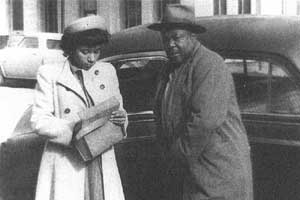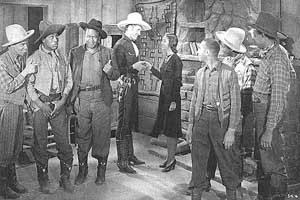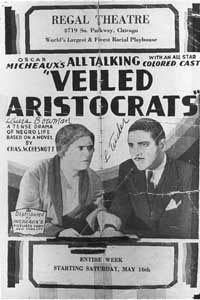Doc Films screening pre-1950s ‘race films’ that students will be discussing in seminar
By Carrie GolusNews Office
 Film still from The Girl in Room 20 Spencer Williams, 1946, 63m |
During Winter Quarter, movie fans will have the chance to see some of the earliest films made by African-American directors.
Doc Films, the independent student film society, will screen a series of rare “race films” every Sunday from Jan. 6 through March 3. The films will be shown at 7 p.m. in the Max Palevsky Cinema in Ida Noyes Hall. Screenings cost $4 and are open to the public.
Race films are black-cast films made before 1950 for segregated African-American audiences. They range in genre from melodramas, thrillers and musicals to comedies and Westerns. These independent productions provided black viewers with images of African-American experience that were conspicuously absent from Hollywood films, including black romance, urban migration, social upheaval, racial violence, alcoholism and color prejudice within the black community.
All the silent films in the Doc series will be screened with live musical accompaniment, as they would have been when first released. A different musical group will perform each week.
 Film still from Harlem Rides the Range Richard Kahn, 1939, 56m |
The first film in the series, Within Our Gates (Oscar Micheaux, 1920), is the earliest surviving film by an African-American director. Released the year after race riots spread through more than 20 U.S. cities, Within Our Gates was initially banned in Chicago because of references to interracial rape and lynching. After an uproar from the African-American community, the local censor board allowed the film to be released with about 25 percent of the original scenes cut out.
Within Our Gates will be shown with live piano accompaniment by Thomas Christensen, Professor and Chairman of the Department of Music.
The film series is being held in conjunction with the graduate seminar “A Separate Cinema? Race Films in Context,” taught by Jacqueline Stewart, Professor in English, Cinema & Media studies and African and African-American studies. Students from Stewart’s seminar will give a short introduction before each screening to help contemporary audiences understand the films’ historical context.
“These movies were known as ‘race films’ because they were intended to uplift the ‘race,’ in the same way that many African-American activists of this era, such as W.E.B. DuBois, referred to themselves as ‘race men,’” Stewart explained. “Many African Americans sought to avoid the terms then in circulation, so instead of using ‘Negro,’ ‘colored,’ or worse, they used the word ‘race,’ as in ‘race men and women,’ ‘race causes,’ ‘race progress,’ ‘race records.’”
 Poster from Veiled Aristocrats Oscar Micheaux, 1932, 44m, 35mm |
Race films, unlike Hollywood films of the time, allowed black actors to display their acting talent in serious dramatic roles. “When actors like Paul Robeson, Lena Horne, Louise Beavers and Noble Johnson appear in race movies, they perform in ways that acknowledge a predominantly African-American audience, and to some extent they move beyond stereotyping,” said Stewart. “Still, many of the films adopt Hollywood genres and character types, raising interesting questions about how progressive these films really are.”
The history of race films begins in 1910 in Chicago, when William Foster, a vaudeville press agent, launched his own film company, the Foster Photoplay Co. It produced primarily slapstick comedies starring black vaudeville performers, and other film companies, such as Ebony Film Corp. in Chicago, quickly followed suit.
By the 1920s, more than 30 race-film companies were producing films destined for black-owned theaters across the country. In Chicago, race films were screened at theaters such as the Grand, the States, and later the Regal and the Met in nearby Bronzeville.
“Race films by maverick African-American directors such as Oscar Micheaux and Spencer Williams laid the groundwork for later black filmmaking, from the commercial successes of 1970s ‘blaxploitation’ films to the stylistic references and social commentary of Charles Burnett, Julie Dash and Spike Lee,” said Stewart.
Doc Films is the longest continuously running student film society in the nation, showing movies every night of the academic year. The cinema has two Eastman Kodak 16mm and two Century 35mm projectors. The projectors’ variable speed capabilities allow Doc Films to present silent films in their original format. For more information, call the 24-hour film line at 702-8575.
![[Chronicle]](/images/small-header.gif)